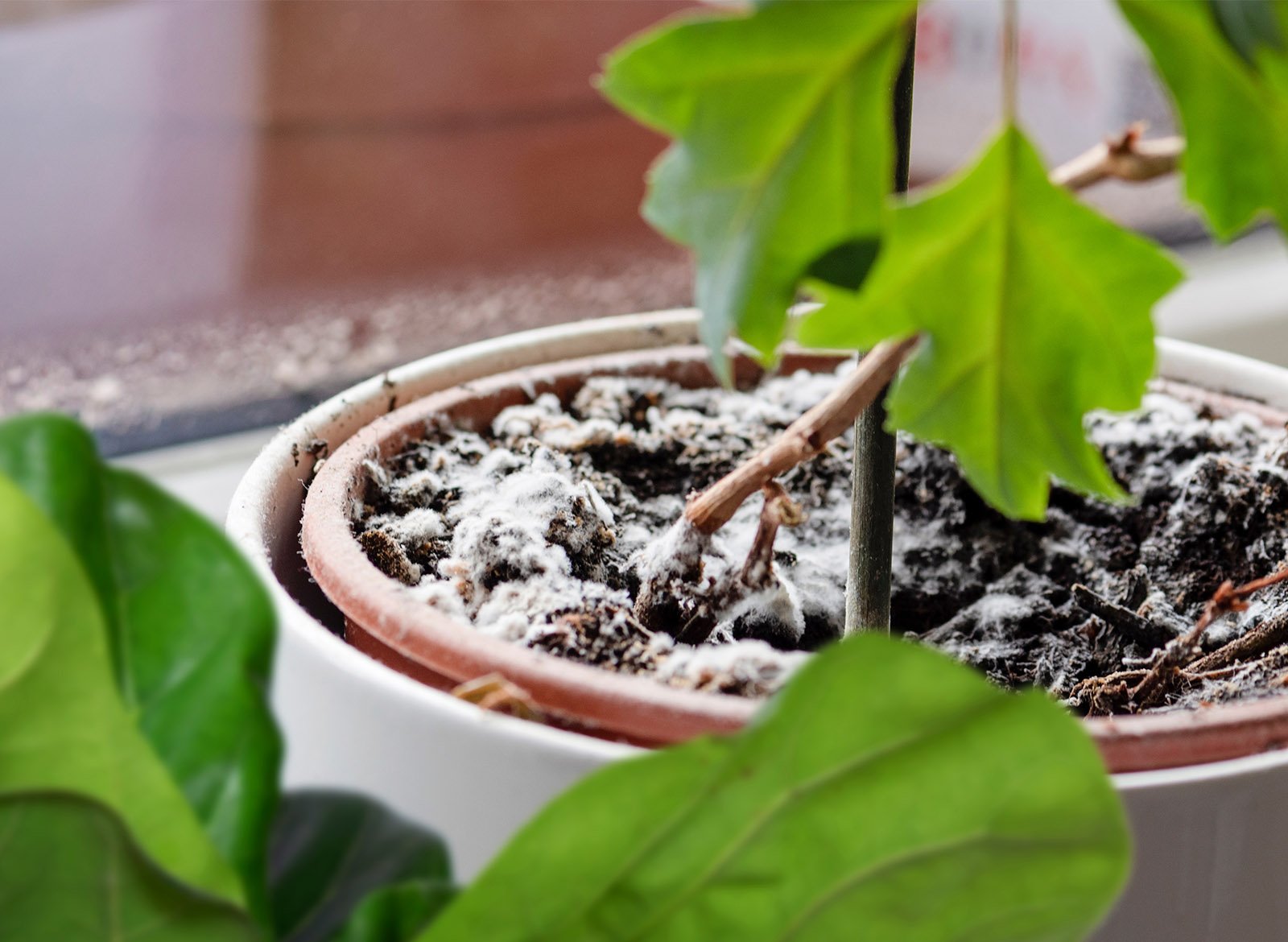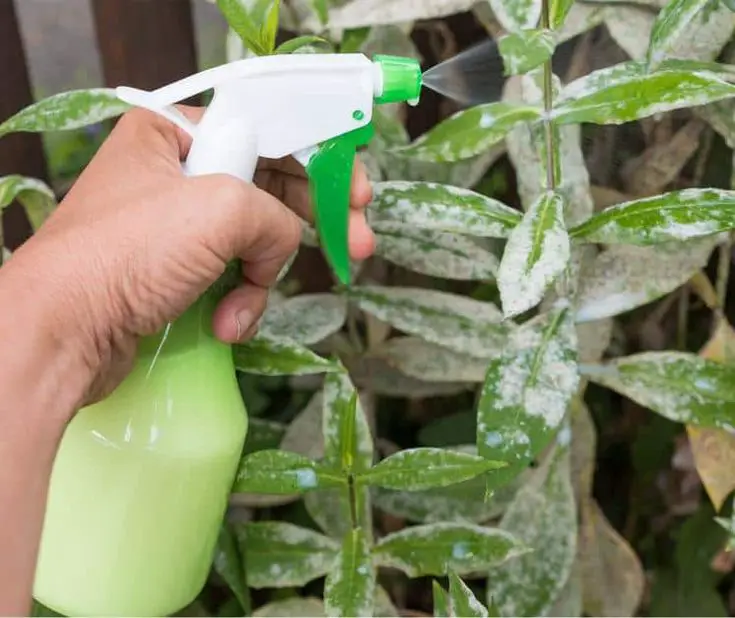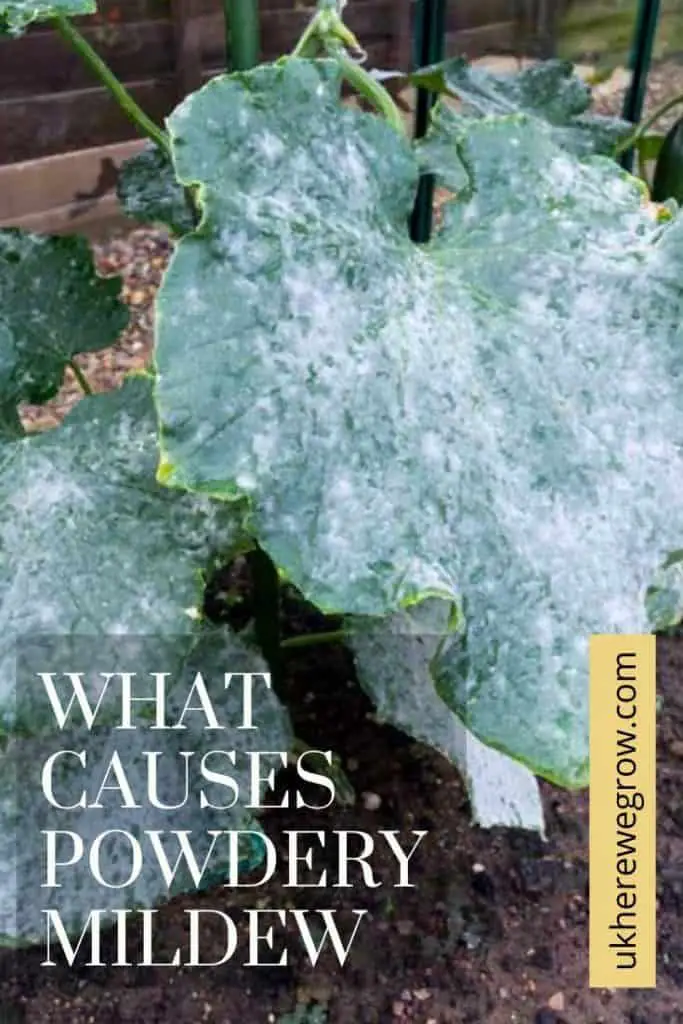Prevent Future Mold Growth
Preventing pesky mold from creeping back requires setting a good foundation for your houseplants. “Start with a high quality potting soil sometimes the soil that plants are growing in when you buy them isn’t the best,” says Dubow. “Repot them as soon as you get home and pay attention to their plant tag so you know how much water and light they needit will keep them healthy. You can also mix a little cinnamon into the top of the soil, since it’s a natural fungicide.”
Only water plants when the soil is dry to the touchand only water the soil, never the leaves of the plant . Also, every container should have drainage holes in the bottom position the pot on a removable saucer to catch excess water, then remove that water 30 minutes after watering. Snip rotting leaves and stems from your plant often and make sure they have enough air circulation. Plants that can tolerate sun can be placed in a south-facing window, where they’ll get bright sun all day.
Reasons To Remove Mold
While in general, mold on plants is not dangerous to humans, some people that are sensitive to mold spores can have a reaction to the mold. For this reason alone, you want to make sure to keep mold growth under control. For some people, exposure to mold can become a life threatening situation.
There is also an aesthetic reason behind removing the mold. It can just make your home look and smell dirty, even if it is otherwise spotless. Even if mold does not currently bother you, it could in the future, the more you are exposed to it.
Eventually, mold can kill your plants by starving it of the nutrients it needs to survive, so you will definitely want to remove it.
Baking Soda To Treat The Molds
One of the most used ingredients that is used as a homemade remedy for almost everything. Your sink is covered with something? Baking soda is for the rescue. You wish to bake a delicious cake? Baking soda would help.
So, there are so many things that baking soda helps us with and today it will help us get rid of the white molds on the plants, so your plants have the healthiest growth.
Let us create a Baking soda Spray for the white molds on plants.
- Take one tablespoon of baking soda in a bowl with ½ gallon of water.
- Add ½ teaspoon of a liquid soap, a dishwasher or any other liquid in the mixture and mix it well.
- Grab an empty spray bottle and fill it with the mixture you created.
- Spray the mixture on the affected parts of the plants wherever you find the white molds.
- Leave the plant and let it dry.
- Repeat the process until the white mold is totally gone.
If you still do not see an effective result after applying this mixture, then you can try mixing potassium bicarbonate into the previous mixture for better results.
While you try mixing all these mixtures make sure you are aware that applying the mixture may affect the growth of your plants. So, avoid applying it on the roots and soil of the plant and if the white mold is on that area, you may need to change the soil occasionally.
Baking Soda for Prevention
Recommended Reading: Getting Mildew Off Leather
How To Prevent Mold In Houseplant Soil
- Use healthy and sterile soil for all newly acquired plants or when changing the soil. Consider using commercial potting soil, which contains plenty of nutrients for your houseplants.
- Avoid overwatering plants. Mold thrives in moist conditions, so too much water will help mold spores to develop. As a rule of thumb, you should water your plants once the top 2 inches or ¼ of the total soil volume is dry.
- Remove debris from the soil and wipe off dust or dirt from the leaves regularly. Leaving organic debris on the soil can provide a better environment for mold to grow. Dont forget to trim dead parts of your plant, as well.
- Provide plenty of light and ventilation to your plants. Sunlight or artificial light is essential not only for your plants growth but also for repelling mold. A source of ventilation, such as a fan on low setting, allows airborne particles to circulate around the plant freely.
Killing Mushrooms With Dish Soap

Yes, eliminating mushrooms with Dish soap is one of the most efficient ways. Let me show you how to make a solution out of dish soap.
Mix 2 tablespoons of dish soap in 2 gallons of water to make a solution. Apply as precisely on the mushrooms as possible.
Make holes around the fungal outgrowths/mushrooms using a screwdriver. Pour this solution over the mushrooms and into the holes.
You may want to scrub dish soap solution on the affected area to eliminate mushrooms.
You can also spray a borate-based fungicide on the mushrooms. By doing this youll ensure that the underlying fungal activity is controlled.
You May Like: Does Tea Tree Oil Treat Toenail Fungus
You May Like: Get Mold Off Ceiling
How To Treat A Mild Infestation Of Mold
For a mild infestation of mold or fungus on the soil in your plants, all you need to do is remove the contaminated soil. Treating the problem before it gets out of hand will save you the trouble of fighting a massive infestation later. This will not just save you time, but also money in the long run.
- Using a small spoon or scoop, you can remove the top ½ to 1 inch of soil. This will remove any fungi or mold that is currently in bloom or growing.
- Be sure to replace any soil that you removed. You want to ensure that the roots of your plants are completely covered.
- You can treat the soil with a light dusting of cinnamon or baking soda to prevent mold from recurring.
- Be sure that you do not water the plant too heavily in the future as moist soil enables growth.
- Wait until the top ½ inch to two inches of the top of the soil is dried out before watering .
- Consider a new place to set your plant to ensure it gets more light to dry the soil faster.
- Adding ventilation can help the soil to dry faster as well. This will help to prevent the mold from returning and an infestation from happening.
Mild infestations will tend to be confined to just a few plants and have not had a chance to spread to all of them. It is better to treat all of your plants, even those that do not seem to be affected as of yet, just to prevent an issue before it arises. Even if the mold is just on the soil at this point, mold can travel on air currents, and it can eventually grow up to the leaves.
Rid Of Flies In A Potted Tomato Plant
Spray both sides of the potted tomato plants leaves with a blast of water. Attach a sprayer head to your garden hose and wash away the immature and adult whiteflies from the leaves. Repeat weekly, or if you notice a reinfestation. Avoid increasing the dish or insecticidal soap, as this can damage the plant. Eliminate any heavily infested, potted tomato plants from the greenhouse or your backyard. A plant that features yellowing leaves and mold is suffering from a serious infestation that will quickly spread.
Related Articles
You May Like: Get Rid Of Black Mold In Basement
How Mold Affects Those With Allergies
Mold on indoor plants has the potential to cause the same allergy symptoms as other molds: itching, sneezing, congestion, dry skin, etc. Because these molds are indoors, the symptoms can be experienced any time of the year as long as the disease is around. Like other types of molds, powdery mildew and white molds can trigger asthma if they reach the lungs or breed for a lengthy period of time.
As such, you never want to take a chance when it comes to mold on indoor plants. If you have a mold allergy, take all the precautions you need to clear it up, even if that means throwing away the entire plant. Molds can be cleared up and treated, but not even a plant is worth risking a severe allergic reaction.
Removing Gray Mold & White Mold
For gray mold and white mold, the plants will not be able to recover after becoming infected. Carefully remove the infected plants from your greenhouse. In doing so, the vital part is to prevent the spores or sclerotia from spreading when you move them. Burn and/or bury the plants after taking them out.
You May Like: How To Clean Mold From Ceiling
Remove Infected Portions Of Plants
To start, use plant clippers to remove or cut back the portions of your plants that have visible powdery mildew on them. If you notice it on a few leaves, remove them from the plant and do not compost them . Wash your hands and clean your clippers with alcohol wipes to further prevent spread of the disease.
What Is Houseplant Mold And What Is Its Function
The harmless white mold is a type of Saprophytic Fungus and is an organism that feeds off and helps to break down organic material. It uses the carbon it gets from organic material to grow and develop. And this is essentially why it likes to turn your damp houseplant soil into a breeding ground.
It is particularly prone to living and feeding off houseplants that are consistently damp or moist, so that should be your first concern. Damp houseplant soil fix it!
Also Check: How To Get Rid Of Black Mold In Basement
How Does This Mold Develop
Mold growth occurs on almost any surface and isnt an indicator of cleanliness. When airborne spores land on a surface and have given the right conditions, i.e. a food source, moisture, warmth and oxygen, they begin to regenerate and grow.
Unfortunately, the potting soil you use for your container plants, especially when grown indoors, is a prime location. The spores feed on organic material found in the potting mix. Your ambient household temperature and the moisture you give your plants can act as a catalyst, causing the furry stuff to take up residence and begin multiplying.
What Does Mold On Mulch Look Like

Mold on mulch can have many different appearances, depending on the type. Some possible mold colors include:
- white
- yellow
- green
You may see anything from white rings on the surface of the mulch to orange, yellow, or brown-colored patches.
There are lots of different types of mold and fungi you could see on your mulch. Here are a few, starting with shotgun fungus.
Also Check: How To Fix Mold On Ceiling
Use Coal As Disinfectant
Coal has not only an absorbent but also a disinfecting element. You have to sprinkle the surface of moldy soil with charcoal.
It will be effective if you grind coal, because the smaller the grinding, the better. You can sprinkle the root neck and the base of the potted plant.
Coal will kill the mold spore and have a beneficial effect on soil conditions. It is useful to add it to the soil not only when mold occurs, but also for prevention.
When you are using coal to eliminate mold, there are several important rules to follow:
- You must change the coal layer every few days. Absorbing pathogenic spores, it becomes an excellent medium for the reproduction of bacteria and new colonies of fungi.
- If you use activated charcoal pellets, in no case you should put them in the pot as a whole. Actively absorbing moisture, the pellet also becomes a breeding ground for mold growth.
How To Get Rid Of White Mold On Plants
White mold on plants looks like a fuzzy substance that is the result of fungus spores. The spores quickly grow on the plant leaves and stems to form a white fuzz thats also called powdery mildew. This white fuzzy mold can affect indoor and outdoor plants, especially when growing conditions are warm, damp, and humid. Although white mold wont kill a healthy plant, it can affect the plants growth. The airborne spores can easily infest nearby plants or create a furry white mold on plant soil.
How to get rid of white mold on plants: to kill mold on indoor plants, you can use a mixture of baking soda, water, and dish soap. Another natural method to get rid of houseplant mold is to make a milk spray, which helps to neutralize the cottony white mold. Neem oil is another natural mold remedy for indoor plants.
Read Also: Removing Mold From Leather
Identifying The Plant Mold
Mold on indoor plants will present differently depending on the type it is. There are kinds that affect the soil, kinds that affect the foliage, and kinds that affect a mixture of both. Luckily, none of them are particularly difficult to identify so long as youve been monitoring your plant regularly. Otherwise, they could easily fly under the radar until its too late.
Effectiveness Of Baking Soda
Outdoors, gardeners can use a variety of antifungal agents to control fungal problems on plants. Popular antifungal agents contain copper and sulfur, which are both toxic materials. These chemicals can be used indoors, however safety instructions must be followed very carefully. These chemicals are toxic to mammals, so avoid ingesting them and wear protective clothing when applying them to your plants. If any pets or children will be interacting with the treated plants, it may be best to avoid using these chemicals or move the plants to a location where they cannot be disturbed.
If you prefer a gentler solution, try using baking soda. Baking soda is an antifungal agent and can even kill some established forms of fungus. Research has shown its effective against some kinds of black spot and powdery mildew. Best of all, baking soda is completely non-toxic for mammals, readily available in any grocery store, and inexpensive.
Don’t Miss: Mold In My Ac Vents
Bleach And Mulch Fungus
Spraying bleach on the mulch can kill the fungus without harming plants if used correctly. In fact, a diluted bleach solution is sometimes used to sterilize and sanitize plant cuttings and growing mediums. Spray the fungus in the mulch with a solution of 1 part bleach and 9 parts water. This weak bleach solution will soften the fungi, allowing you remove them from the mulch.
The removal of the fungi varies depending on the type growing in the mulch. Pull the mushrooms and stinkhorns with a gloved hand, scoop slime mold up with a garden shovel, and wipe artillery fungus off with a damp rag after applying the bleach solution. Keep in mind, however, that spraying the mulch with bleach may not get rid of fungus and could only be a temporary fix. That is why it is important to figure out the underlying cause of the fungal growth such as excessive moisture or poor drainage and correct the problem to keep the fungus from returning.
Dont Miss: Can Vinegar Kill Foot Fungus
What To Do With Powdery Mildew
With powdery mildew, there are some natural remedies that have been tried and tested. To combat this type of mold, add two teaspoons of cider vinegar to one liter of water and spray it over your plants. This should do the trick. Another method is to mix 60% milk and 40% water and spray this on them, and this should also work some magic.
Recommended Reading: Water Filter Mold
What Is Tomato Leaf Mold
Leaf mold of tomato is caused by pathogen Passalora fulva. It is found throughout the world, predominantly on tomatoes grown where the relative humidity is high, particularly in plastic greenhouses. Occasionally, if conditions are just right, leaf mold of tomato can be a problem on field grown fruit.
Symptoms start as pale green to yellowish spots on upper leaf surfaces that turn a bright yellow. The spots merge as the disease progresses and the foliage then dies. Infected leaves curl, wither, and often drop from the plant.
Flowers, stems, and fruit may be infected, although usually only leaf tissue is affected. When the disease does manifest on the fruit, tomatoes with leaf mold become dark in color, leathery, and rot at the stem end.
How Do I Get Rid Of The Mold On My Plant Soil

Some gardeners swear by cinnamon as a natural anti-fungal. Simply wipe off the mold and sprinkle the spot with some cinnamon from your spice drawer.
If cinnamon doesnt work, Gaumond says to try a houseplant fungicide spray or a homemade baking soda and water mixture. Test any solution on a small part of your plant to be sure it isnt too strong. Once youve removed and treated the mold, its important to address what allowed mold growth in the first place. Find the root cause, then adjust your plant care accordingly.
Recommended Reading: How To Get Mildew Off Bathroom Ceiling
Symptoms Of Plant Molds
Symptoms of mold are usually visible on various parts of a plant. If you expose your plant to less light and high humid environment, then you are likely to observe the following features on your plant.
The powdery deposits appear on buds, leaves or shoots of a plant and can make the entire shoot white dirty. Though the mildew is unlikely to kill the plant, it weakens and damages the roses. The following are other symptoms of fuzzy mold attacks.
- Wilting of leaves
- Kalanchoe
